

A dumpling is a dumpling – and hardly any other dish epitomises tradition, down-to-earthness and genuine enjoyment more. Whether you enjoy it in a savoury or sweet version, classic or modern – the dumpling is a true all-rounder. There is an eternal debate in Germany about whether they are called „Kloß“ or „Knödel“ – in the south they are usually called “Knödel”, in the north, they are referred to as “Kloß”. However, no matter what you call them – they are always delicious. And it’s also worth taking a look outside the box: International dumpling variations demonstrate the diversity of this dish around the world – from Asian dumplings to South American versions. The addition of fresh herbs such as marjoram or parsley perfectly rounds off every dumpling dish, giving it that certain something.



The history of the dumpling goes back a long way and is deeply entrenched in European tradition. Even in the Middle Ages, the dish was prepared from simple ingredients such as potatoes, flour or breadcrumbs. The dumpling used to be particularly popular with farmers and farm labourers as it was nutritious, cheap and easy to prepare.
Especially in Thuringia, the dumpling has become a true culinary institution. There, the „Thuringian dumpling“ is an integral element of regional cuisine and is often served with roasts, game dishes or as a side dish. The „Thuringian dumpling“ has had its own seal of quality since 2014, protecting its authenticity and artisan production. Only those who adhere to traditional production methods are allowed to bear the coveted seal of quality.

Growing potatoes on the balcony is an easy way to harvest fresh, home-grown tubers for your own kitchen. New potatoes, which are sprouted in spring and can be harvested quickly, are particularly suitable for this. In summer, you can enjoy your own potatoes, which are perfect for homemade dumplings.
How about simply growing the potatoes for your dumplings yourself? With a potato tower or planting bag on the balcony or patio, this saves space and is as simple as child’s play. Not only will you bring fresh greenery into your home; you’ll also have the perfect base for homemade dumplings.


Planting bag
A special planting bag for potatoes is ideal, as it is well ventilated and offers the potatoes’ root system sufficient space to grow. Make sure that the bag is stable and has enough drainage holes to prevent waterlogging.
Potato tower
The potato tower is a particularly space-saving and creative option. This is a type of raised bed in which several tubs or rings are stacked on top of one another. The tower can be made of wire mesh, wood or special potato tower sets. This way, you can also grow potatoes on the balcony or patio without requiring a lot of space. The benefit: The potato tower offers plenty of space for the roots and ensures good ventilation.

Seed potatoes: : Buy special seed potatoes from the garden centre or use normal potatoes, but bear in mind that they may contain diseases.
Give time to germinate: Let the seed potatoes germinate in a cool, light place, for 1-2 weeks before planting. The little „eyes“ should sprout.

Prepare the soil: Use loose, well-aerated soil, for example a mixture of potting soil, compost and a little sand. This way, the soil is nutrient-rich and stores water, in addition to allowing the drainage of excess moisture.
Fill the soil: Fill the planting bag or potato tower halfway with soil. Make sure that the soil is well aerated to avoid waterlogging.

Plant sprouting potatoes: As soon as the potatoes have sprouts of about 2-3 cm in length, they can be planted. Place the sprouts in the soil with their eyes facing upwards and cover them with about 5-10 cm of soil.

Heaping: Once the plants have started growing and have reached a height of about 20-25 cm, heap the soil around the stems so that the potatoes are well protected and have enough space to grow. Repeat this heaping at regular intervals to protect the tubers from sunlight and foster growth.
Watering and care: Potatoes need regular watering, during the hot summer months. Ensure that the soil is always moist, but not too wet, as waterlogging can damage the roots. Fertilise the plants with an organic vegetable or potato fertiliser, as needed.

When: Potatoes are usually ready for harvest after about 3-4 months. The time has come to dig up the potatoes when the plants turn yellow and the leaves wither. In a potato tower, to harvest the ripe potatoes, you can open the lowest rings first, without having to dismantle the entire tower.
Storage: Store your harvested potatoes in a cool, dry place so that you can enjoy them for longer. A cellar or a dark room is best suited for storage.
Whether in a potato planting bag or in a potato tower – potatoes can be grown wonderfully on the balcony or terrace. The potato tower offers plenty of space and ensures that the plants are well ventilated. This way, you can have a rich harvest in a small space – and process it into dumplings right away!
Fresh herbs always add a special something to every dish! Whether classic, exotic or surprisingly different – be sure to bring the flavour and aroma directly into your kitchen or onto your balcony.
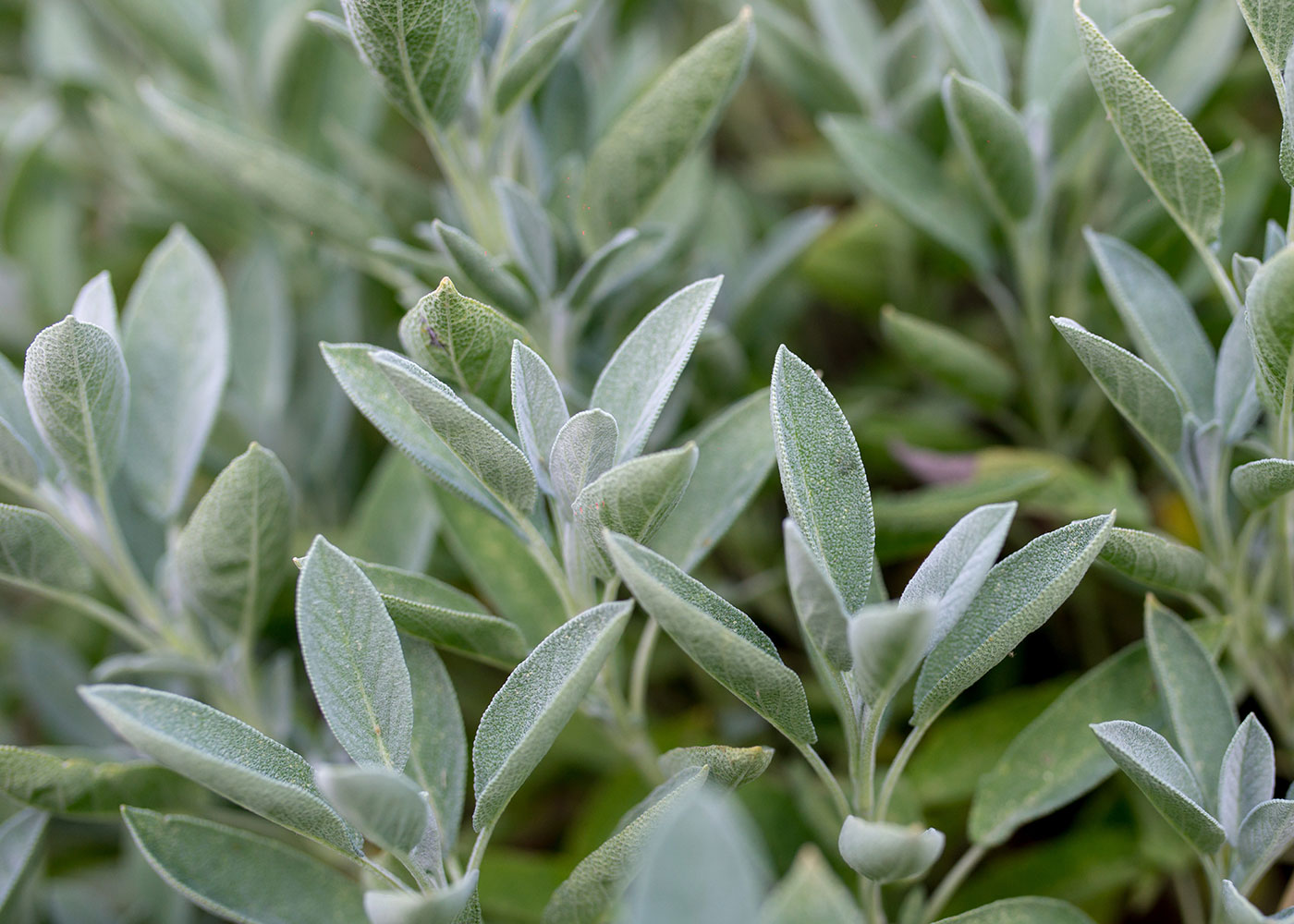
Sage is a great herb that goes perfectly with dumplings and is easy to grow on your balcony!
Its intense, slightly bitter flavour harmonises wonderfully with the buttery note of dumplings - especially if you fry the leaves in butter and use them to refine your dumplings. A true flavour experience!
Cultivation on the balcony:
Sage loves sunny, dry places and is extremely low-maintenance. It needs little water and is even perennial if you protect it in winter. Simply perfect for anyone who is looking for an uncomplicated, aromatic herb!
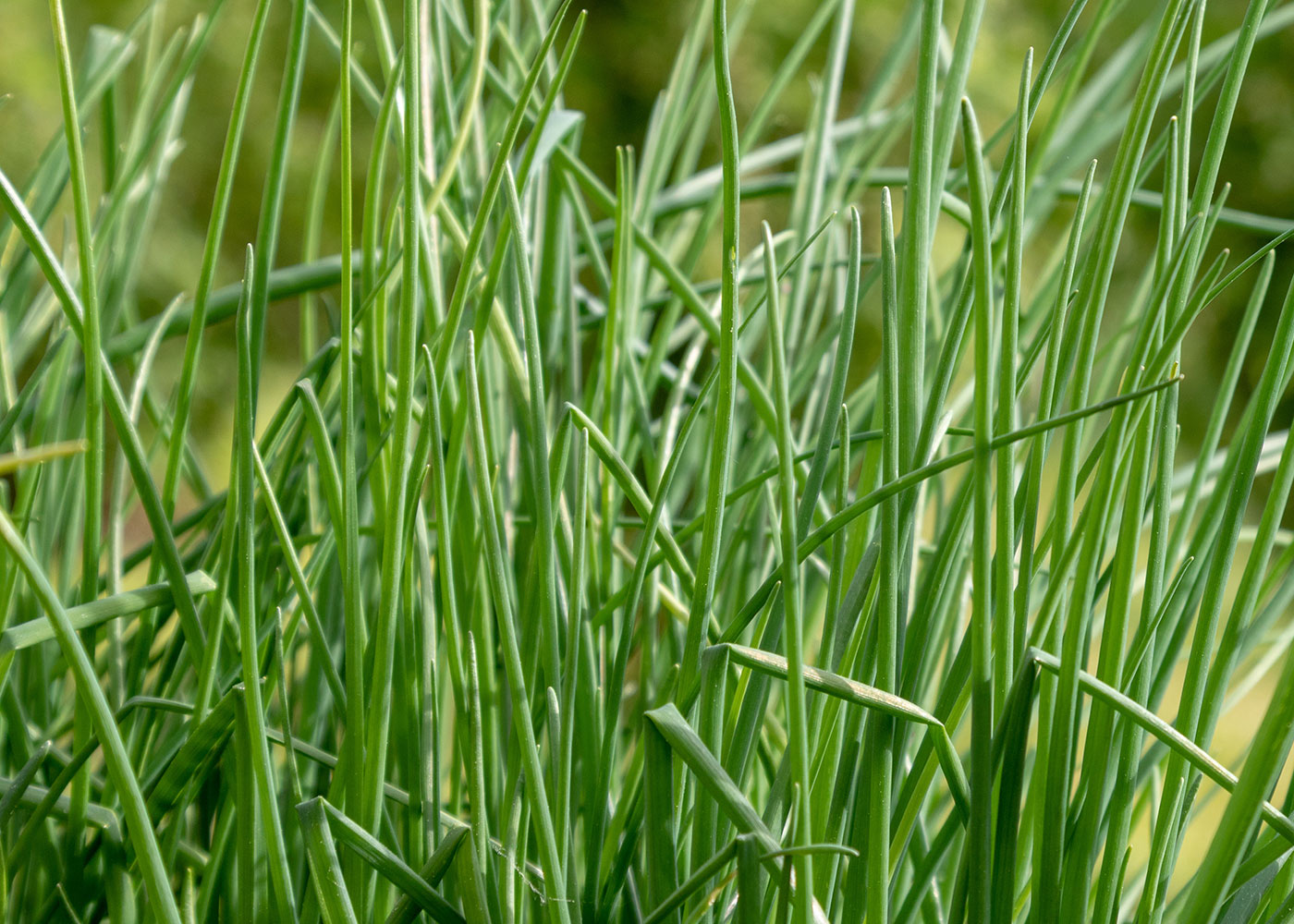
An all-rounder in the kitchen and an absolute must-have for fresh, regional herb fans: chives!
Thanks to its mild, onion-like flavour, it adds a special something to soups, salads, potato dishes, and more. Freshly chopped, it unfolds a wonderful aroma and adds colour to the plate - perfect when used as a topping or ingredient for dips and quark.
Cultivation on the balcony:
Chives appreciate a bright location, preferably with some partial shade. It is perennial and will grow back time and again if you cut it back regularly. Simply plant it in a pot or box - and you'll always have fresh greenery!

Chervil is the fine, elegant herb that adds a touch of freshness to soups, sauces and egg dishes. Its delicate, slightly sweet flavour is reminiscent of parsley that is combined with a hint of aniseed - indispensable for the classic "Frankfurt Green Sauce"!
Cultivation on the balcony:
Chervil loves semi-shady spots and loose, moist soil. It grows quickly, making it ideal for anyone who wants to harvest fresh leaves regularly. Another advantage: Chervil is also ideal for small balconies!

The star of the spring season: wild garlic! With its spicy, slightly garlicky flavour, it refines pestos, soups and quiches. It is particularly popular as an ingredient for fresh bread or homemade wild garlic butter.
Cultivation on the balcony:
Wild garlic prefers shady to semi-shady locations and moist, humus-rich soil. In spring, it sprouts quickly and vigorously - making it perfect for a fresh harvest right on your doorstep. Note: From May onwards, wild garlic is usually bitter when in flower, so be sure to harvest before then!
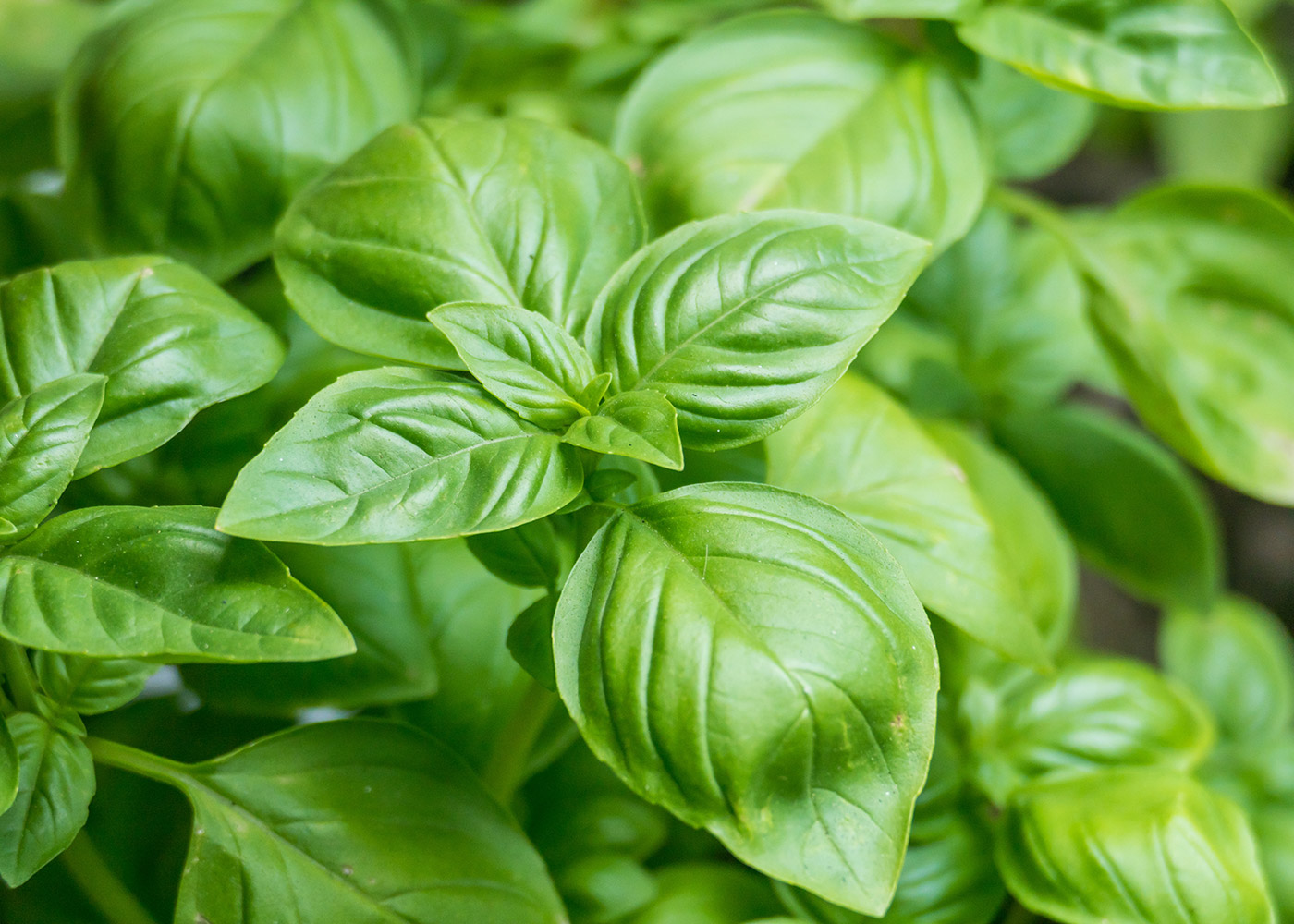
The Mediterranean all-rounder par excellence: basil! Its unmistakable, sweet and spicy flavour goes perfectly with tomatoes, mozzarella, pasta or pizza. Freshly-picked basil conjures up the taste of summer straight onto your plate.
Cultivation on the balcony:
Basil loves the sun and needs a warm, sheltered spot. Always keep the soil slightly moist, but avoid waterlogging. Tip: Cut back basil regularly so to ensure bushy and vigorous growth. Ideal for fresh enjoyment all summer long!
The dumpling is a true globetrotter! There are so many variations of this simple, yet delicious, dish found all over the world. Whether savoury or sweet, steamed or deep-fried – dumplings always have their own history and special preparation. Let’s go on an exciting trip and discover the diversity of dumplings worldwide.


These potato dumplings are a delicious way to use up leftover potatoes. They are crispy on the outside and creamy on the inside.
500 g cooked potatoes
100 g cream cheese
50 g grated cheddar
1 egg
100 g breadcrumbs
salt and pepper (to taste)
vegetable oil for frying
1. Mash the cooked potatoes and mix them with the cream cheese, cheddar, salt and pepper.
2. Add the egg and mix well.
3. Shape the mixture into small balls and roll them in breadcrumbs.
4. Fry the balls in a pan with hot oil, until golden brown.
5. Place on kitchen paper to absorb oil and serve while warm, for example as a snack or side dish to a savoury meal.
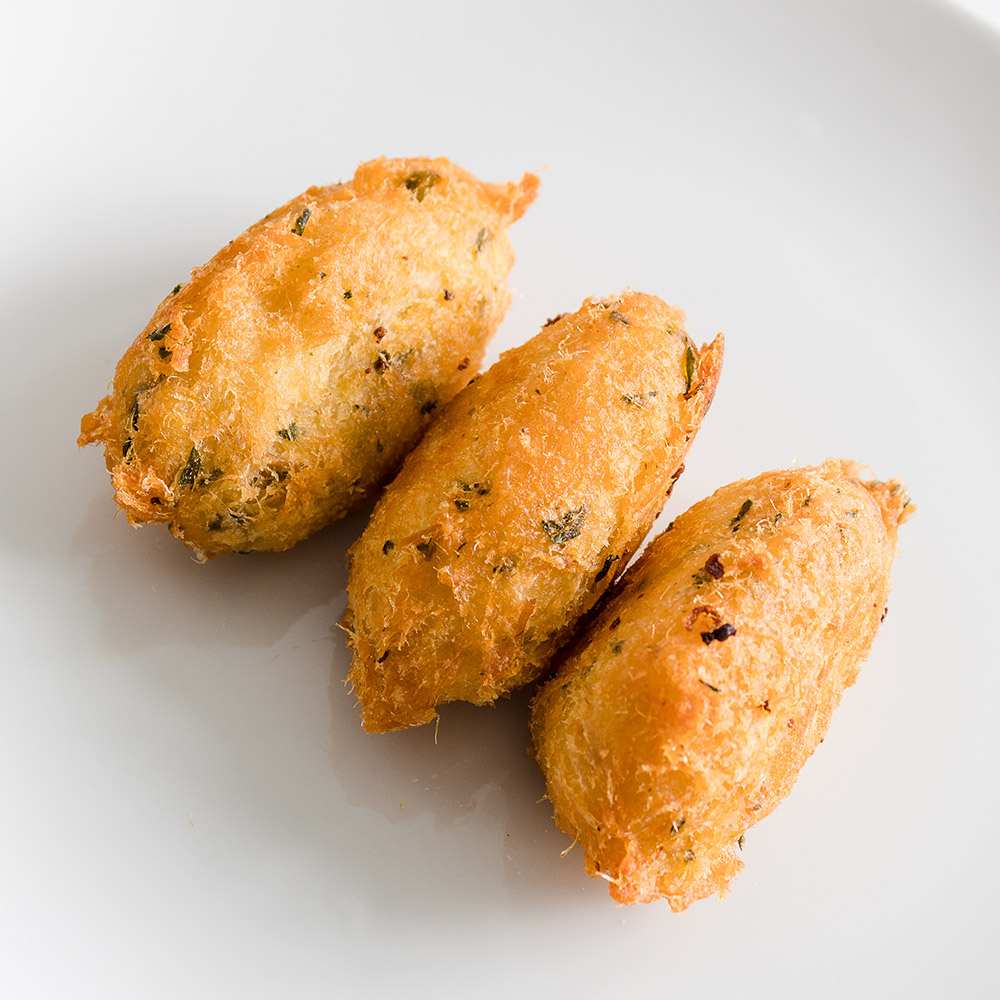

These deep-fried cassava dumplings are a delicious snack from Brazil and are often served with meals or as a snack.
500 g cassava (cooked and mashed)
1 egg
1/2 cup grated Parmesan cheese
2 tbsp flour
1 onion, diced
salt and pepper (to taste)
Oil for deep-frying
1. Mash the cooked manioc and mix it with the egg, Parmesan, flour, onion, salt and pepper.
2. Shape the mixture into small balls.
3. Heat the oil in a pan and fry the balls until they are golden brown and crispy.
4. Place on kitchen paper to absorb the excess oil, then serve.
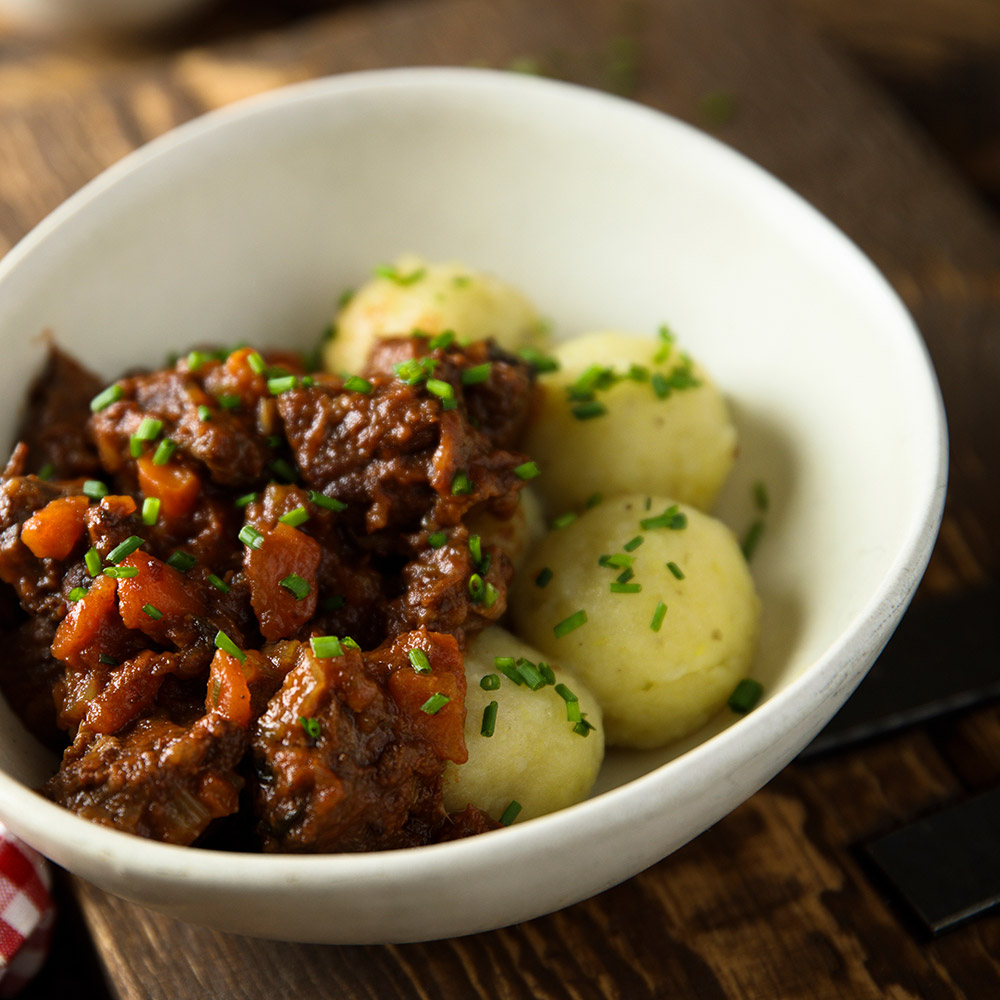

These dumplings traditionally accompany roast beef with gravy and go perfectly with hearty goulash.
500 g wheat flour
1 egg
200 ml water
1 tsp salt
1 tsp baking powder
1. In a bowl, mix the flour, egg, water, salt and baking powder together well until you have a smooth dough. The dough should be soft but not too sticky.
2. Divide the dough into small portions and roll each portion into a longish dumpling.
3. Cook the dumplings in a large pot of boiling salted water for about 20 minutes until they rise to the surface.
4. Remove with a ladle, let them drain off well, and then place them on a plate.
5. Serve with hearty goulash or roast beef.


Fufu is a traditional West African dish made from manioc and plantain. It is eaten as a side dish with many dishes such as stews or soups.
500 g manioc
2 ripe plantains (or plantains)
Water
1. Peel the manioc and plantains and cut them into pieces.
2. Cook the pieces in a large pot of water until they are soft (approx. 30-40 minutes).
3. Drain the ingredients and pound them in a mortar or with a pestle until smooth.
4. Place the fufu in a bowl and work it into a thick, elastic mixture.
5. Serve with a spicy sauce or a meat stew.
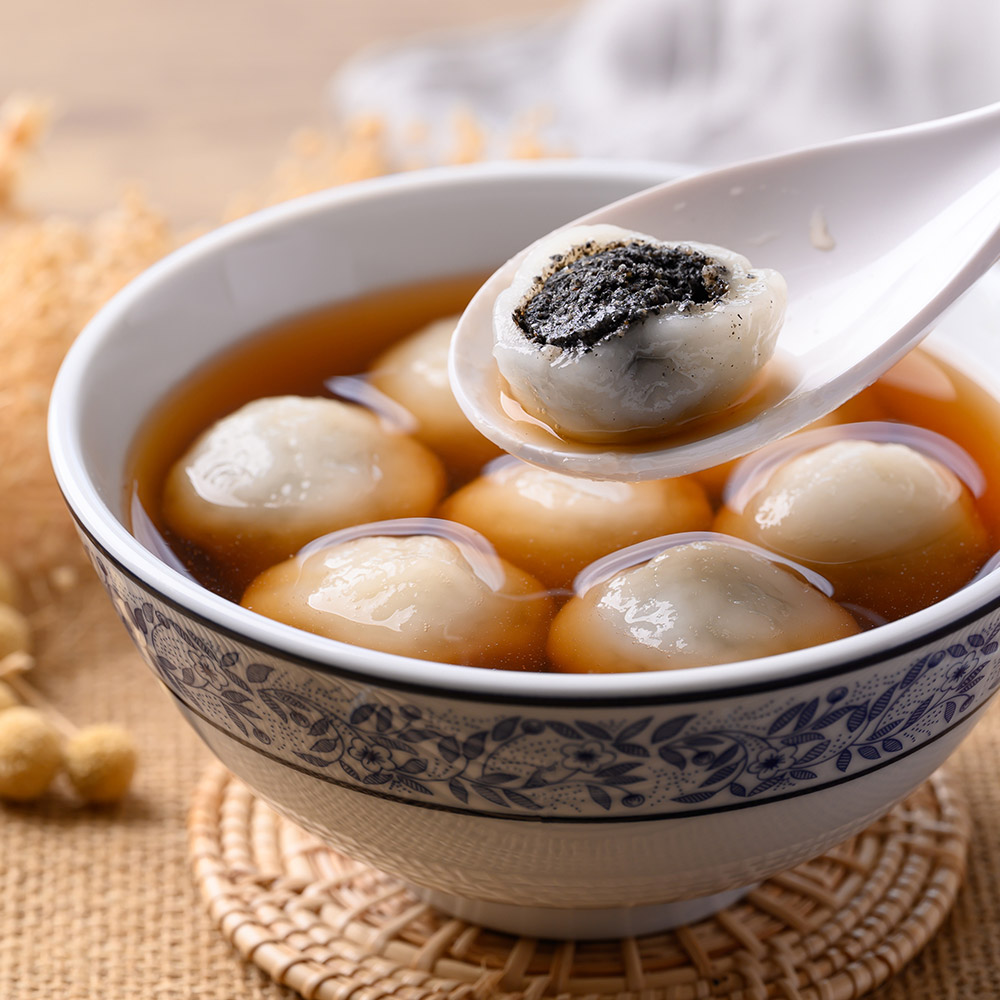

Tangyuan are sweet rice dumplings served in a sweet broth. Especially popular during the Lantern Festival in China.
200 g glutinous rice flour
100 ml warm water
100 g red bean paste (or black sesame paste)
100 g sugar
1 cinnamon stick
1. Mix the glutinous rice flour and warm water in a bowl until you have a smooth dough.
2. Shape the dough into small balls and fill the centre of each ball with a teaspoon of red bean paste.
3. Bring the water to the boil in a pot and add the cinnamon stick.
4. Place the tangyuan in the boiling water and cook for about 10 minutes until they rise to the surface.
5. Dissolve the sugar in a little water in a separate bowl and serve the dumplings in this sweet liquid.
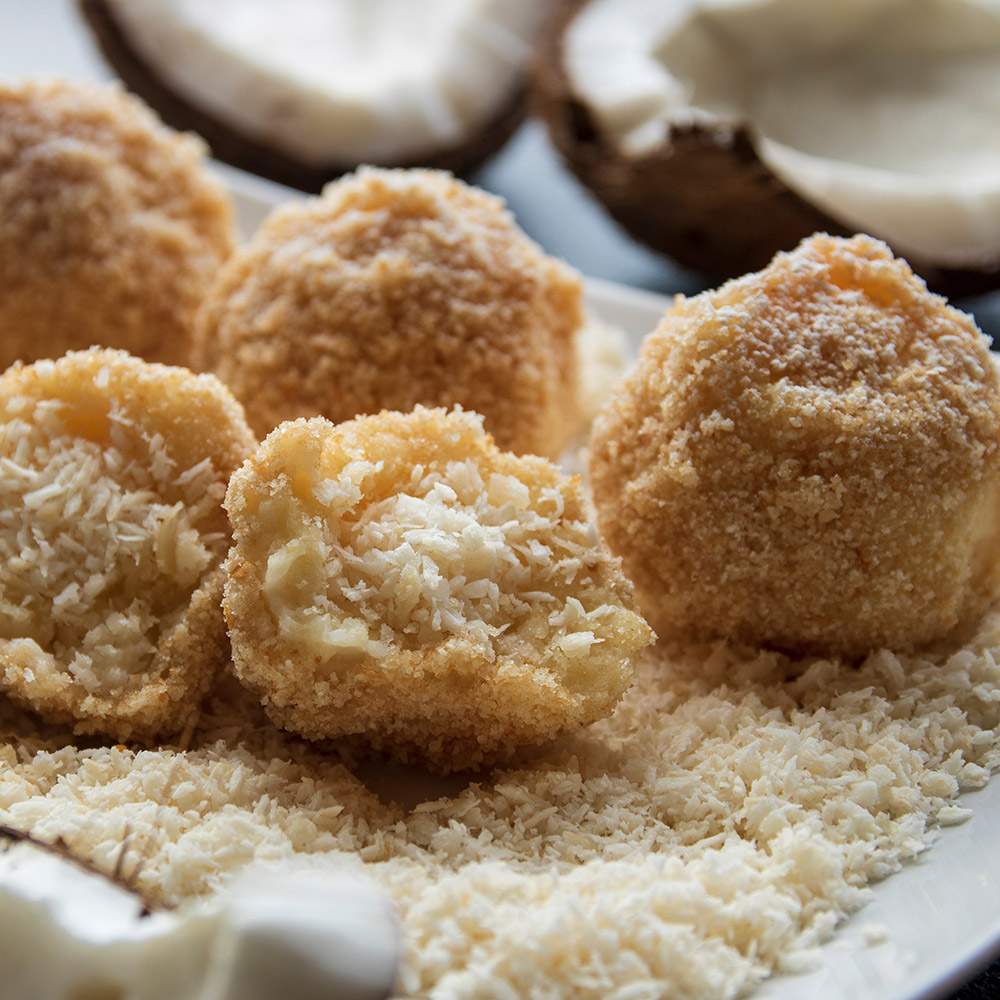

For the dumplings:
500 g Kūmara (New Zealand sweet potatoes, alternatively: orange sweet potatoes)
200 g manioc flour or cornflour (e.g., tapioca starch, alternatively: normal flour)
100 g grated coconut (toasted for extra flavour)
1 tsp salt
1 tsp grated lime zest
1 pinch of cinnamon or nutmeg (optional, for a slightly sweet flavour)
For the dip:
200 ml coconut cream
Juice of 1 lime
1 tsp grated ginger
1 tbsp honey or brown sugar
1 pinch of salt
Fresh mint or coriander leaves (to garnish)
For the finish:
Toasted sesame seeds or grated coconut for sprinkling
Optional: a little melted butter or coconut oil for extra shine
1. Prepare the dumplings:
Peel the kūmara, cut it into pieces and cook until soft (about 15 minutes). Drain well and mash to a fine puree.
Knead the puree with the manioc flour (or cornflour), grated coconut, salt, lime zest, and cinnamon/nutmeg to form a smooth dough. The dough should be slightly sticky but still malleable. Add a little more flour if necessary.
Shape the mixture into walnut-sized balls.
2. Cook the dumplings:
Carefully place the dumplings in the water and cook over low heat for approx. 8-10 minutes until they rise to the surface.
Remove and drain.
3. Prepare the dip:
Heat the coconut cream in a small pan (do not boil!).
Stir in the lime juice, grated ginger, honey, and a pinch of salt. Mix everything well and season to taste. Pour the dip into a bowl and garnish with mint or coriander leaves.
4 Finish and serve:
Arrange the cooked dumplings on a plate and garnish with toasted sesame seeds or grated coconut. To give them a nice shine, the dumplings can briefly be tossed in a little butter or coconut oil before serving.
Serve with the coconut and lime dip.
The world’s largest dumpling to date was prepared in Jena on 1 May 2010 – weighing in at a proud 365 kilograms! Cooking time 8 hours.

Do you remember fusion food? An innovative „Thuringian dumpling doughnut“ was offered for sale at the Christmas market in Erfurt – a creative fusion of traditional dumpling and doughnut that was so well received that the operators had to double their supplies!

Dumpling as a monument: In Bad Langensalza, a town in Thuringia, there is a monument dedicated to a dumpling. And there is also a dumpling museum in dumpling-crazy Thuringia.

For the salad:
800 g beetroot
400 g lamb’s lettuce
40 g garden cress
For the dressing:
200 g raspberries
2 tbsp raspberry vinegar
8 tbsp olive oil
1 tbsp honey
salt, pepper
For the goat’s cheese balls:
80 g hazelnuts
2 stalks of parsley
½ bunch of chives
200 g fresh goat’s cheese
salt, pepper
Wash and peel the beetroot and slice it thinly.
Wash the lamb’s lettuce and cress and spin it dry.
Place the raspberries in a bowl and mash them with a fork. Add the raspberry vinegar, olive oil and honey to the raspberries and mix well. Season to taste with salt and pepper.
Chop the hazelnuts roughly and gently roast them in a pan, without oil, until fragrant.
Wash the parsley and chives and chop finely. Mix the fresh goat’s cheese with the herbs and season with salt and pepper. Form the mixture into small balls and roll them in the cooled hazelnuts.
Arrange the beetroot and lamb’s lettuce on plates and serve. Sprinkle the cress on top and drizzle the raspberry vinaigrette over the salad. Place the goat’s cheese balls on top of the salad.


For the dumplings:
4 stale bread rolls
100 ml milk
1 onion
40 g butter
200 g mountain cheese
2 stalks of parsley
2 eggs
1 tbsp vegetable oil
Salt, pepper & nutmeg
For the vegetable stock, with root vegetables:
200 g carrots
200 g celery
200 g parsnips
100 g leek
2 litres of vegetable stock
salt, pepper
For the chervil oil:
4 stalks chervil
4 tbsp olive oil
Salt
Dice the bread roll and place in a bowl. Bring the milk to the boil, pour it over the cubes and put aside to soak. Peel the onion and slice it finely. Heat 20 g butter in a pan and fry the chopped onion until translucent. Cut the mountain cheese into cubes and chop the parsley finely. Mix the soaked bread cubes with the eggs, onions, diced cheese, and chopped parsley. Season with salt, pepper and a pinch of nutmeg. Shape the mixture into eight flat dumplings. Heat the oil in a pan with the remaining butter and fry the dumplings on both sides until golden brown in colour.
Peel the carrots, celery and parsnips and, with the leek, cut into fine strips. Heat the vegetable stock in a pan. Add the chopped root vegetables and simmer for about 10-15 minutes until the vegetables are soft. Season to taste with salt and pepper.
Wash the chervil and shake dry. Then blend it together with the olive oil until you have a fine oil. Flavour with a pinch of salt.
Place the cheese dumplings in a soup plate. Pour the hot vegetable stock with the root vegetables over the dumplings. Drizzle the chervil oil over the soup.

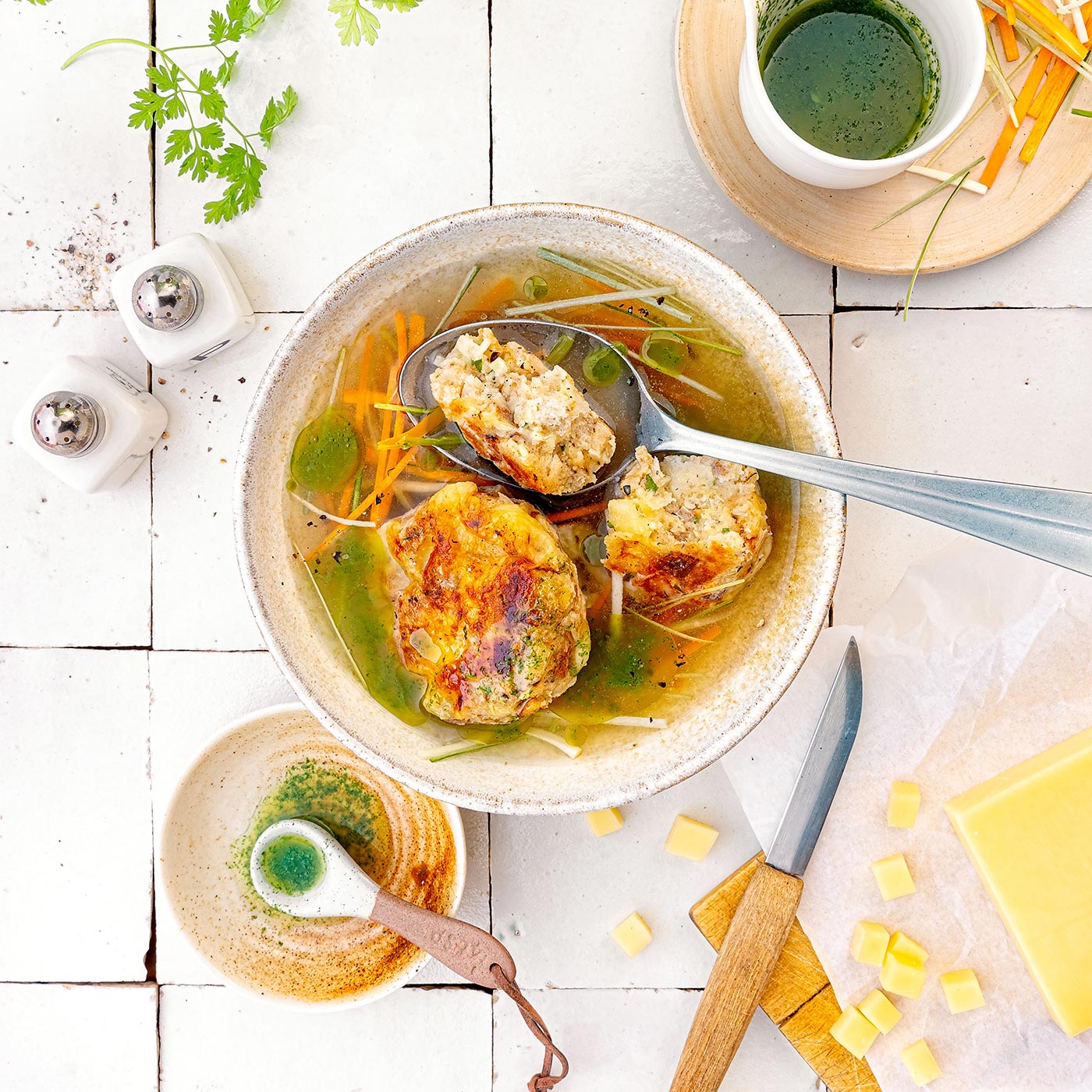
For the potato dumplings:
800 g potatoes
2 eggs
4 tbsp flour
1 tbsp cornflour
Salt & nutmeg
For the spring vegetables:
400 g green asparagus
200 g snow peas
400 g cherry tomatoes
4 tbsp olive oil
salt, pepper
For the wild herb salad:
200 g wild herb salad
4 tbsp olive oil
4 tbsp balsamic vinegar
salt, pepper
For the wild garlic pesto:
100 g pine nuts
100 g wild garlic
50 g Parmesan cheese
200 ml olive oil
salt, pepper
Wash the potatoes, then boil them in salted water until they are soft. Drain and put them aside to cool down a little. Peel the potatoes and press them through a potato ricer or mash them thoroughly. Mix the potato mixture with the eggs, flour, cornflour, salt, and nutmeg until you have a smooth dough. Shape the dough into small dumplings and cook them in gently simmering salted water for about 15 minutes until the dumplings rise to the surface.
Wash the green asparagus and cut off the woody ends. Cut the asparagus into bite-sized portions. Wash the snow peas and remove the ends.
Wash and halve the cherry tomatoes. Heat the olive oil in a pan and sauté the asparagus and snow peas until they are al dente. Finally, add the tomatoes and fry briefly. Season to taste with salt and pepper.
Wash and dry the wild herbs. Mix the olive oil, balsamic vinegar, salt and pepper to make a dressing, and then mix in the herbs.
Roast the pine nuts in a pan without oil and put aside to cool. Wash and dry the wild garlic. Place the wild garlic in a tall container with the grated Parmesan, half the pine nuts and the olive oil and blend into a fine pesto. Season to taste with salt and pepper.
Arrange the potato dumplings on a plate. Garnish the spring vegetables around the dumplings and place the wild herb salad next to them. Either drizzle the wild garlic pesto over the dumplings and vegetables or serve separately and sprinkle with the remaining pine nuts.

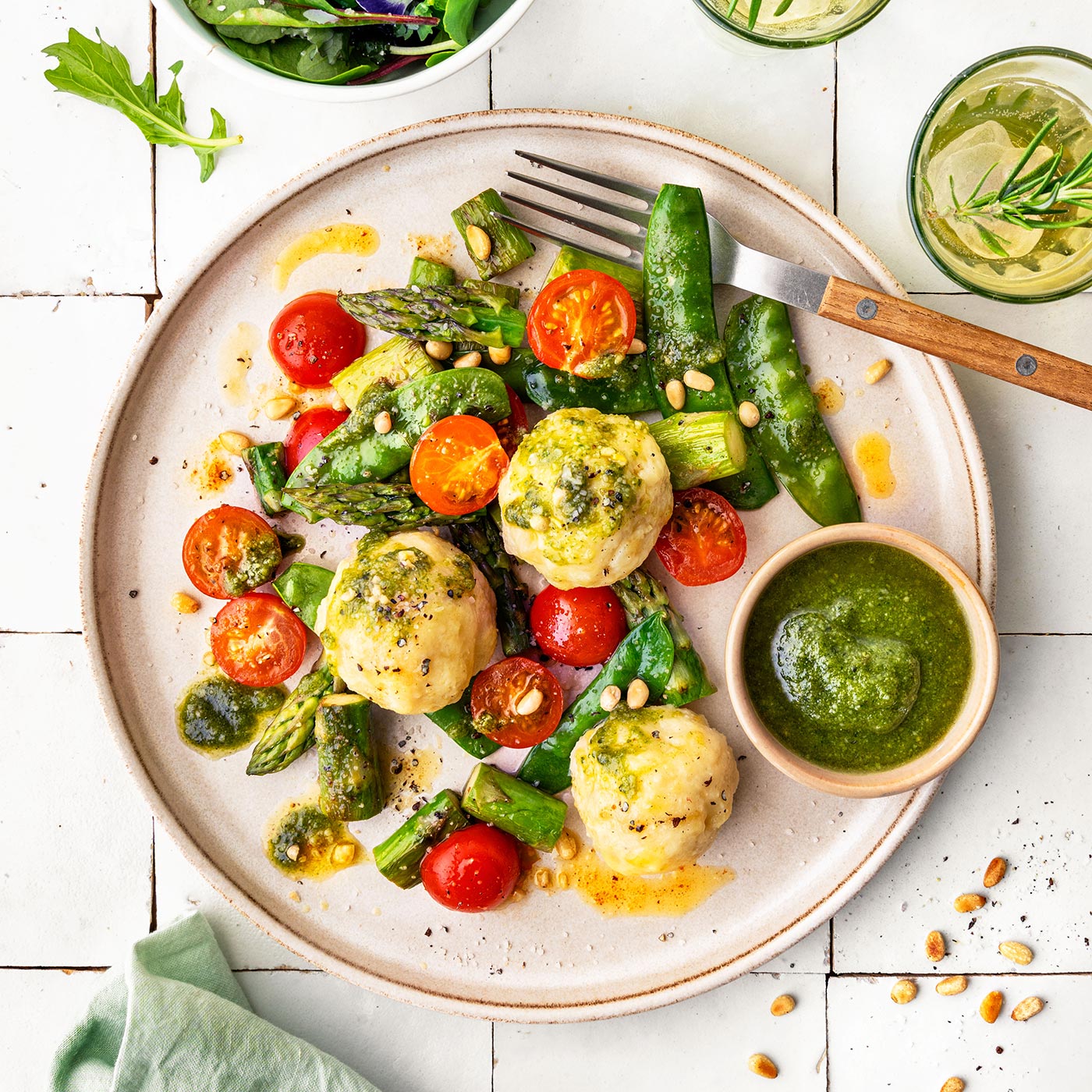
For the dumplings:
500 g quark
4 eggs
170 g durum wheat semolina
40 g flour
40 g sugar
1 lemon
Salt
For the butter crumbs:
120 g butter
120 g breadcrumbs
Sugar & cinnamon
For the strawberry and basil salad:
400 g strawberries
4 stalks of basil
Mix the quark, eggs, durum wheat semolina, flour, sugar, a pinch of salt and the zest of the lemon well in a bowl. Place the mixture in the fridge for at least 30 minutes so that the semolina can swell. Squeeze the lemon and put the juice aside for the strawberry and basil salad.
Use two spoons to shape the dumpling mixture into small dumplings. Bring water to the boil in a pot, add a little salt and reduce the heat so that the water only simmers gently. Place the dumplings in the water and put aside for about 10-15 minutes until they rise to the surface. Then carefully remove and drain.
Melt the butter in a pan. Add the breadcrumbs and roast over medium heat until golden brown. Flavour with sugar and cinnamon.
Wash and clean the strawberries and cut them into small pieces. Cut the basil into fine strips and mix together with the strawberries in a bowl. Flavour with lemon juice.
Serve the strawberry and basil salad on a plate. Roll the quark dumplings in the buttered breadcrumbs and place on top of the salad.


© apetito catering B.V. & Co. KG, 2024
§ 1 Veranstalter, Anwendungsbereich, Gewinnspiel
Der Veranstalter veranstaltet ein Gewinnspiel und stellt dafür einen oder mehrere Preise bereit, die nach Maßgabe der nachfolgenden Bestimmungen an die oder den Gewinner (m/w/d) ausgehändigt werden.
Veranstalter des Gewinnspiels ist die apetito catering B.V. & Co. KG, Bonifatiusstraße 305, 48432 Rheine, (Amtsgericht Steinfurt, HRA 5828, Sitz: Rheine; Umsatzsteuer-Identnummer: DE 815 101 064) vertreten durch die persönlich haftende Gesellschafterin apetito catering Europe B.V. mit Sitz in Denekamp (NL) (Eingetragen im Handelsregister Kamer van Koophandel, voor Oost Nederland: 08204028 ), diese vertreten durch den Geschäftsführer Herrn Andreas Oellerich.
Diese Teilnahmebedingungen und Datenschutzbestimmungen gelten für das Gewinnspiel „Food for fans“ (nachfolgend „Gewinnspiel“).
§ 2 Teilnahmeberechtigung
Teilnahmeberechtigt am Gewinnspiel sind alle Personen, die das 18. Lebensjahr vollendet haben. Ausgeschlossen sind Mitarbeiter der apetito catering B.V. & Co. KG sowie Mitarbeiter der mit der apetito catering B.V. & Co. KG verbundenen Unternehmen (wie z.B. apetito catering Education B.V. & Co. KG oder Menüpartner B.V. & Co. KG).
§ 3 Teilnahme, Voraussetzungen & Frist
Die Teilnahme an dem Gewinnspiel ist kostenlos.
Der Teilnehmer (m/w/d) nimmt an dem Gewinnspiel teil, wenn er die Teilnahmebedingungen einhält. Der Teilnehmer muss unter anderem das Teilnahmeformular wahrheits- und ordnungsgemäß ausfüllen. Teilnehmer kann immer nur eine bestimmte natürliche Person sein. Juristische Personen können nicht teilnehmen. Eine mehrfache Teilnahme etwa unter Pseudonym oder weiteren E-Mail-Adressen ist ausgeschlossen und führt zum Ausschluss von dem Gewinnspiel. Ausgeschlossen werden auch Personen, die sich unerlaubter Hilfsmittel bedienen oder sich anderweitig durch Manipulation Vorteile verschaffen. Gegebenenfalls können in diesen Fällen auch nachträglich Gewinne aberkannt und zurückgefordert werden. Wer unwahre Personenangaben macht, kann vom Gewinnspiel ausgeschlossen werden.
Für die Teilnahme am Gewinnspiel ist zudem die Angabe von personenbezogenen Daten notwendig, nämlich: Anrede, Privatname, Lieferadresse, Name des Betriebsrestaurants, E-Mail-Adresse.
Sollten Sie der Verarbeitung Ihrer personenbezogenen Daten im Rahmen dieses Gewinnspiels vor der Verlosung und Gewinnerermittlung widersprechen, ist Ihre Teilnahme an dem Gewinnspiel nicht mehr möglich.
Während der Dauer des Gewinnspieles müssen die Teilnahmevoraussetzungen erfüllt sein. Die Teilnahmeerklärung (Teilnahmeformular) muss auf dem vom Veranstalter angebotenen Weg firstgemäß mit den erforderlichen Daten übermittelt werden. Eine Teilnahme auf anderen Wegen als vom Veranstalter vorgegeben, ist nicht möglich und führt zum Ausschluss bzw. Nichtberücksichtigung im Gewinnspiel.
Die Gewinner werden unter allen teilnahmeberechtigten Teilnehmern per Zufallsprinzip (Losverfahren) ermittelt und per E-Mail über den Gewinn benachrichtigt. Bei Ablehnung des Gewinns wird eine erneute Auslosung per Zufallsprinzip unter allen teilnahmeberechtigten Teilnehmern durchgeführt.
Meldet sich der Gewinner (m/w/d) nicht innerhalb von 10 Tagen nach dem Absenden der Benachrichtigung, so verfällt der Anspruch auf den Gewinn. Der Anspruch auf den Gewinn verfällt ebenfalls, wenn die Übermittlung des Gewinns nicht innerhalb von 2 Monaten nach der ersten Benachrichtigung über den Gewinn aus Gründen, die in der Person des Gewinners liegen, erfolgen kann.
Teilnahmefrist ist vom 10. Februar bis zum 14. Februar 2025.
§ 4 Datenschutz
Die von Ihnen im Teilnahmeformular mitgeteilten personenbezogenen Daten (Anrede, Privatname, Lieferadresse, Name des Betriebsrestaurants, E-Mail-Adresse) werden zum Zweck der Durchführung und Abwicklung des Gewinnspiels genutzt. Rechtsgrundlage ist dabei der Art. 6 Abs.1 lit.a sowie Art. 6 Abs.1 lit. b DSGVO. Verantwortlich für die Datenverarbeitung im Sinne der DSGVO ist die apetito catering B.V. & Co. KG. Eine Übermittlung Ihrer Daten an Dritte findet nicht statt. Der Datenschutzbeauftragte der apetito catering B.V. & Co. KG sowie ihrer verbundenen Unternehmen ist Christian Hammerbacher, SPH IT + Consulting GmbH & Co. KG, Telefon: 0911 / 21 77 48 0, E-Mail: Datenschutz@sph-consulting.de.
Sie können von Ihrem Recht auf Auskunft, auf Berichtigung Ihrer Daten, auf Löschung, auf Einschränkung der Verarbeitung, Ihrem Widerspruchsrecht oder auf Datenübertragbarkeit Gebrauch machen. Hierzu können Sie uns über Datenschutz@sph-consulting.de kontaktieren. Im Übrigen haben Sie das Recht, sich bei der zuständigen Datenschutzaufsichtsbehörde zu beschweren. Durch den Widerruf der Einwilligung wird die Rechtmäßigkeit der aufgrund der Einwilligung bis zum Widerruf erfolgten Verarbeitung nicht berührt. Eine weitere Teilnahme an dem Gewinnspiel ist dann nicht mehr möglich.
Ihre Daten werden nur so lange aufbewahrt, wie es gesetzlich zulässig ist. Eine Löschung findet in der Regel nach Abschluss des Gewinnspielverfahrens statt, spätestens nach drei Jahren.
§ 5 Zusendung Information, Gewinnchance, Gewinn
Die Einwilligung zur Zusendung von Informationen bzw. Werbung stellt keine ausschließliche Teilnahmeberechtigung für das Gewinnspiel dar und hat daher keinen Einfluss auf die Gewinnchance. Der Teilnehmer/in kann die erklärte Einwilligung zur Zusendung von Informationen/Werbung jederzeit widerrufen. Ihren Widerspruch senden Sie bitte an info@apetito-catering.de.
Der Gewinn: Unter den Teilnehmenden verlost die apetito catering B.V. & Co. KG 1x ein Tablet, 2x ein Fondue/Raclette-Set und 3x ein Kochbuch. Eine Barauszahlung des Gewinns ist nicht möglich.
§ 6 Rechtsweg
Der Rechtsweg ist ausgeschlossen.
Sie sehen gerade einen Platzhalterinhalt von Vimeo. Um auf den eigentlichen Inhalt zuzugreifen, klicken Sie auf die Schaltfläche unten. Bitte beachten Sie, dass dabei Daten an Drittanbieter weitergegeben werden.
Mehr InformationenSie sehen gerade einen Platzhalterinhalt von YouTube. Um auf den eigentlichen Inhalt zuzugreifen, klicken Sie auf die Schaltfläche unten. Bitte beachten Sie, dass dabei Daten an Drittanbieter weitergegeben werden.
Mehr InformationenSie müssen den Inhalt von reCAPTCHA laden, um das Formular abzuschicken. Bitte beachten Sie, dass dabei Daten mit Drittanbietern ausgetauscht werden.
Mehr Informationen